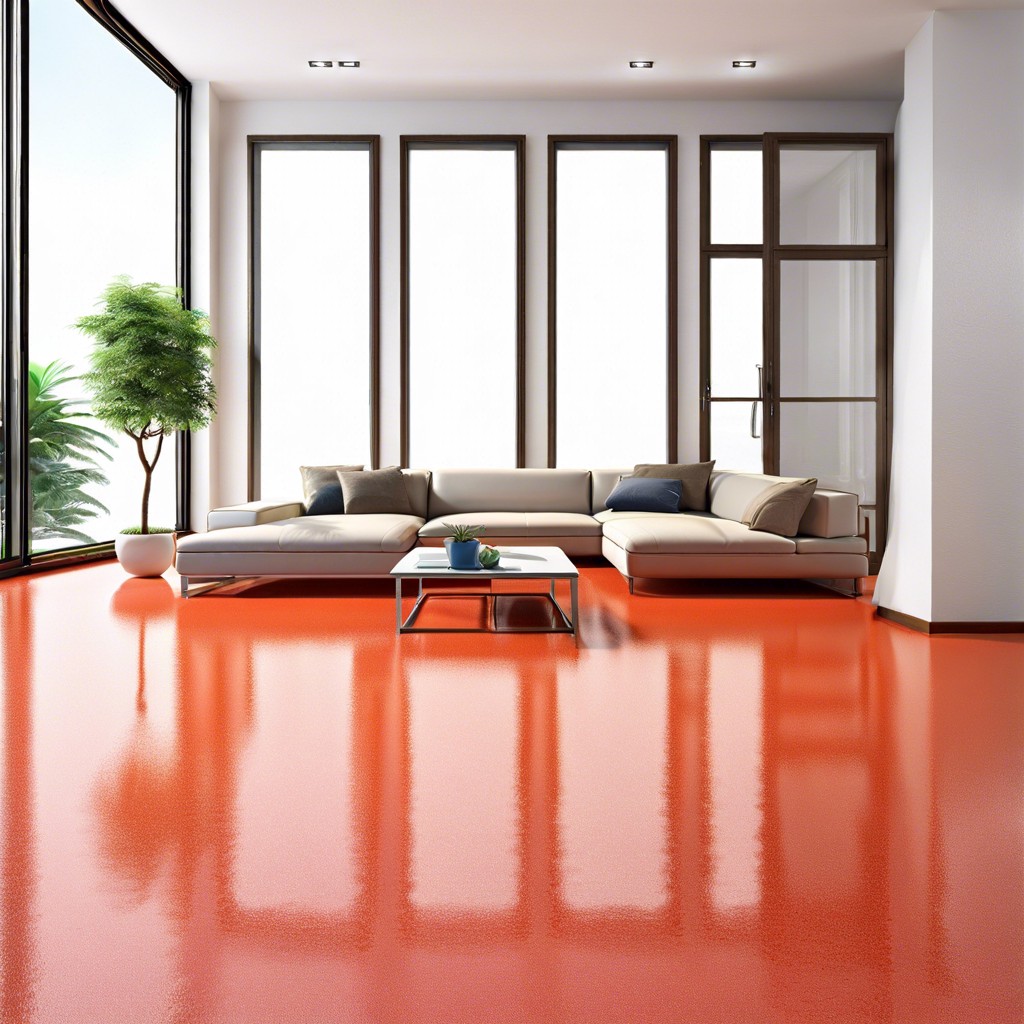Polymer flooring, a modern marvel, is designed to provide durable, easy-to-clean surfaces perfect for both homes and industrial spaces.
Key takeaways:
- Epoxy coatings for heavy traffic, glossy finish.
- Polyurethane resistant to chemicals, ideal for hospitals.
- Acrylic quick dry, for spaces needing frequent updates.
- Polyaspartic cures fast, great for retail stores.
- Benefits include allergen resistance and easy maintenance.
Different Types of Polymer Floor Coatings

Epoxy coatings are super durable and can handle heavy traffic, making them perfect for places like warehouses and garages. Plus, they come in a shiny, glossy finish, because who doesn’t want their garage floor to be the envy of the neighborhood?
Polyurethane coatings are like the superheroes of the flooring world. They’re resistant to chemicals and UV light, which means they won’t turn yellow or brittle over time. Ideal for commercial kitchens and hospitals where spills happen more than we’d like to admit.
Acrylic coatings are quick to dry and easy to apply. If you’re someone who likes to get things done fast, this one’s for you. They work well in spaces that need frequent updating without a lot of downtime.
Polyaspartic coatings are the speed demons of the bunch. They cure in no time, so the area can be back in action faster than you can say “polyaspartic.” Great for retail stores and showrooms where interruption means lost sales.
Understanding these types can feel like picking a superhero team for your floor. Each has its own strengths and superpowers, so choose wisely!
Health Benefits of Polymer Flooring
Firstly, polymer flooring is a wizard at keeping dust and allergens at bay. Thanks to its seamless nature, there are no joints or crevices where nasties can hide and thrive. Imagine a floor that doesn’t act like a giant petri dish. Fantastic, right?
Another health perk is its resistance to mold and mildew. Mold is like that uninvited creepy uncle at a family gathering—no one wants him around. Polymer flooring’s non-porous surface does an excellent job of keeping moisture out, hence keeping mold from crashing the party.
Cleaning polymer flooring is easier than spelling “abracadabra.” A simple mop and mild detergent usually do the trick. Reduced use of harsh chemicals means fewer toxic fumes floating around, and that’s great news for your lungs.
Lastly, some polymer floors come with anti-microbial properties. Yes, they fight germs like a tiny army in your home or workplace. Ideal for places where hygiene is critical, like hospitals and kitchens, these floors politely show bacteria and fungi the exit door.
Case Studies of Successful Polymer Flooring Installations
In a bustling airport, polymer flooring flew high with zero turbulence. Faced with millions of footfalls daily, traditional floors might buckle under pressure. Instead, the polymer flooring stayed strong, weather-resistant, and easy to clean. Travelers remained on safe, non-slip surfaces—even on rainy days.
In a school gym, polymer flooring transformed dodgeball from dangerous to delightful. The surface absorbed impact, reducing injuries and echoing cheers instead of painful thuds. Maintenance staff beamed as clean-up became a breeze, withstanding sweaty, sticky sneakers and spilled sports drinks.
Museums also gave a nod to polymer flooring. Its durability preserved the pristine look despite heavy foot traffic. Plus, easy installation meant less downtime, so exhibits stayed open and visitors stayed happy.
In industrial settings, polymer flooring faced some heavy lifting. Forklifts, heavy machinery, and chemical spills met their match without damaging the floor. Maintenance costs dropped, and the floors retained their original sheen, even under the harshest conditions.
Considerations for Building Owners and Architects
When contemplating polymer flooring, building owners and architects should focus on durability first. You don’t want your shiny new floor looking like it just tangoed with a herd of elephants after a few months.
Think about maintenance. Polymer floors are low maintenance, meaning fewer headaches down the line. Easy cleaning equals happy janitors.
Safety is another key. Polymer flooring often has anti-slip properties, which is excellent news unless you’re secretly harboring dreams of becoming an ice-skating rink owner.
Architects, don’t forget aesthetics. Polymer flooring comes in a variety of colors and finishes. You can have a floor so chic, it could make a runway jealous.
Cost is crucial. Upfront, polymer flooring can be pricier compared to other options. However, consider the long-term savings on maintenance and the extended lifespan.
Finally, there’s installation time. Traditional materials may require weeks of curing. Polymer flooring? Faster installation means quicker project completion. Time is money after all.
Solutions for Contractors and Distributors
Contractors and distributors have a lot on their plate when dealing with polymer flooring. Here are a few quick tips to make life easier:
Firstly, always ensure proper surface preparation. If the floor isn’t clean and smooth, it’s like trying to paint on a lumpy pancake—just won’t work.
Invest in good quality products. Cheap materials might save a buck now, but they’ll cost you in headaches (and repairs) later.
Training is crucial. Make sure your team knows the ins and outs of installation. A well-trained crew can mean the difference between a floor that’s a masterpiece and one that looks like modern art gone wrong.
Stock the right tools. You wouldn’t cut a steak with a spoon, so don’t expect to install polymer flooring without the proper gear. Rollers, scrapers, and mixers are your new best friends.
Lastly, get to know your suppliers. Building a good rapport can mean better deals, faster deliveries, and a hotline for those late-night ‘uh-oh’ moments.
Remember, a smooth installation leads to happy clients and fewer stressed-out contractors.
Recap




